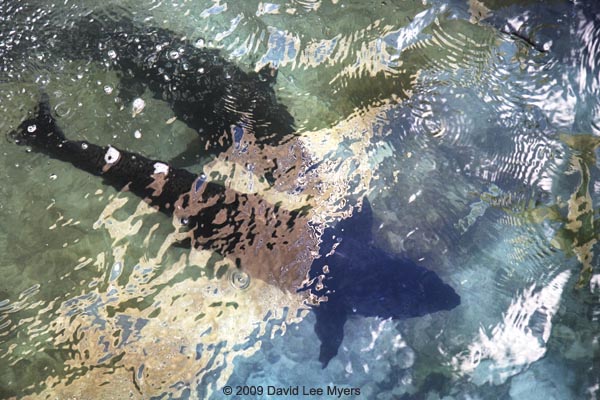River of Gifts

Chinook Burial Canoe. This replica of a Chinook burial canoe was placed on Coxcomb Hill in 1961 by descendents of the great chief Comcomly. I want to always remember that the Clatsops and other Chinook groups had a long established thriving life here, until European diseases brought by traders decimated them in the early 1800s. Fortunately, some people of Clatsop and other Chinook ancestry remain living here today as a vital part of our culture. Astoria, Oregon, 2007.
River of Gifts: the Columbia
Our great river is older than the hills,
older than the volcanoes flanking its great stem,
older than the thrust up coastal range it cuts through,
more ancient than the basaltic cliffs it flows between.
Its splendor today arouses us, and reminds us where we are, and when.
Just yesterday people knew it as Wauna, today as Columbia,
and always as a River of Gifts.
What gifts?
Columbia’s gifts have long been food, transportation, and water.
And a spiritual presence.
A spiritual presence?
A reminder that we are part of other peoples, of other places, of a bigger nature.
Our story is one thread in the weaving.
Columbia and its Salmon connect us to mountain snows and streams,
and to gravel beds for wild salmon eggs.
Columbia and its Salmon connect us to electric turbines, to irrigated fields and orchards.
Great ships trade with the world, while wheat barges and tough little fishboats feed the world.
Above all, Columbia and Salmon connect us
to the people who lived here before us, and
to the people who will live here after us.
Columbia is our canvas, to paint lives of looking, wandering, and working,
exploring currents and winds and hidden sloughs, exploring our own strength and skill.
Columbia is our freedom to see so much more than ourselves,
and learn a little.
She is our independence to work, to fish against the odds, and prevail,
our freedom to choose, for better, for worse,
and learn a little.
Columbia’s steadfast rift through the mountains ushers the oceanic rains inland,
and the continental cold to the coast, season by season.
Each nuance of weathered skies shows its own textures and colors:
The fierce beauty pierces the veil of words and concerns which consume our daily efforts,
offering to expand the reach of our perception and caring.
Even after a century of industrialization,
She lives with a touch of wildness, of power and form beyond our control.
A strange yet needed gift is reproach:
A reproach for our shortsightedness,
For our militant opportunism,
as we sacrificed so much of the future
For a little advantage just now.
In a world so marred by human destructiveness,
Awaken to a Columbia dawn:
Awaken into refreshed awareness that we can do well,
Awaken into refreshed awareness that we can do good.
And when the day is done, a Columbia dusk reassures
that much is still right with the world,
so we may sleep well.
Can we live mindfully and find a thoughtful balance between utilization and wildness?
What happens when we live here as if living here matters?
As if living matters, as if here matters? As if the future matters.
For the grandchildren, for generations beyond numbering.
We were born into the opportunity to be aware, to care, and to create meaning in action.
For the love of life, I say, play it for all it’s worth.
Is there any reason to settle for less?
© 2008 David Lee Myers
Views from Home are also of the Columbia River.

Tule Fall Chinook No.2. Sunlight sparkles on the water as salmon swim up the fish ladder to their home hatchery. This “white salmon” variety has lighter flesh and darker skin than others, giving the name to the White Salmon River where it originates. Spring Creek National Hatchery near White Salmon, Washington. 2009.

Redmen Hall on Skamokawa Creek. Looking down Skamokawa Creek from a foot bridge, we see houses oriented towards the water and docks. Two commercial gillnet fishing boats remind us that the traditions of an old fishing village live on. Overlooking the scene is Redmen Hall, originally built as a school house, now home to the River Life Interpretative Center, and called by the name of a fraternal organization which used it for a while. Wahkiakum County, Washington, 2007.

Raistakka Barn. A steep rise and sharp turn of the Altoona-Pillar Rock Road gave this view of a barn, Grays River, and a hay field downstream from Rosburg, on the lower Grays River. Wahkiakum County, Washington, 1980.

Oris Smalley’s Dock at Devil’s Elbow. The dock is on the Grays River between Rosburg and its mouth on Grays Bay. The river was well used by the commercial fishing community. High water is the normal result of a spring tide combining with heavy runoff. Wahkiakum County, Washington. 1981.

Big Red on the Altar. One day on the River Walk in 2003, I noticed Big Red appearing beyond a concrete fixture which reminded me of an altar. By stepping down the bank and lining up just right, I could visually place Big Red on that altar, suggesting its sacred role in our community.
Big Red is all about water. Built to support commercial fishing on our river, it stands on pilings far from shore—water ebbing and flooding underneath. In its next incarnation, it housed artists’ studios—and when I worked in the building, it swayed and creaked with the motions of the water. The Columbia’s winds shake it and carry the fragrances of a great river. The December, 2007 hurricane blew the third floor roof and most of Royal Nebeker’s painting studio into the river. He rebuilt his studio and continued efforts to preserve the building. Camerawork 2003 and 2009, compositing 2009. Astoria, Oregon.